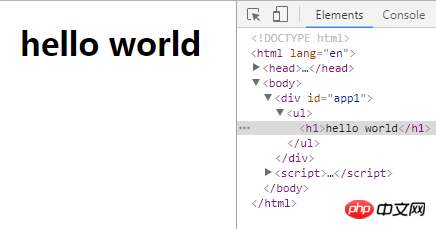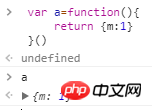Rumah >hujung hadapan web >tutorial js >Vue全局组件与局部组件详解
Vue全局组件与局部组件详解
- 小云云asal
- 2018-05-28 14:23:461907semak imbas
本文主要介绍了Vue组件之全局组件与局部组件的使用详解,具有一定的参考价值,感兴趣的小伙伴们可以参考一下,希望能帮助到大家。
组件 (Component) 是 Vue.js 最强大的功能之一。组件可以扩展 HTML 元素,封装可重用的代码。在较高层面上,组件是自定义元素,Vue.js 的编译器为它添加特殊功能。在有些情况下,组件也可以是原生 HTML 元素的形式,以is特性扩展。个人认为就是一个可以重复利用的结构层代码片段。
全局组件注册方式:Vue.component(组件名,{方法})
eg:
<body>
<p id="app">
<my-component></my-component>
</p>
<p id="app1">
<my-component></my-component>
</p>
<script>
Vue.component("my-component",{
template:"<h1>我是全局组件</h1>"
});
new Vue({
el:"#app"
});
new Vue({
el:"#app1"
})
</script>
</body>渲染结果:
<p id="app"> <h1>我是全局组件</h1> </p> <p id="app1"> <h1>我是全局组件</h1> </p>
这里需要注意:
1.全局组件必须写在Vue实例创建之前,才在该根元素下面生效;
eg:
<body>
<p id="app">
<my-component></my-component>
</p>
<p id="app1">
<my-component></my-component>
</p>
<script>
new Vue({
el: "#app"
});
Vue.component("my-component", {
template: "<h1>我是全局组件</h1>"
});
new Vue({
el: "#app1"
})
</script>
</body>这样只会渲染app1根元素下面的,并不会渲染app根元素下面的,并且会报错。
2.模板里面第一级只能有一个标签,不能并行;
<body>
<p id="app">
<my-component></my-component>
</p>
<script>
new Vue({
el: "#app"
});
Vue.component("my-component", {
template: "<h1>我是全局组件</h1>" +
"<p>我是全局组件内标签</p>"
});
new Vue({
el: "#app1"
})
</script>
</body>这样子会报错,并且只会渲染第一个标签h1;我们应该这样子写:
<body>
<p id="app">
<my-component></my-component>
</p>
<script>
new Vue({
el: "#app"
});
Vue.component("my-component", {
template: "<h1>我是全局组件<p>" +
"我是全局组件内标签</p></h1>"
});
new Vue({
el: "#app1"
})
</script>
</body>局部组件注册方式,直接在Vue实例里面注册
eg:
<body>
<p id="app1">
<child-component></child-component>
</p>
<script>
new Vue({
el: "#app1",
components:{
"child-component":{
template:"<h1>我是局部组件</h1>"
}
}
});
</script>局部组件需要注意:
1.属性名为components,s千万别忘了;
2.套路比较深,所以建议模板定义在一个全局变量里,代码看起来容易一点,如下:(模板标签比较多的时候,这样子写更加简洁规整)
<body>
<p id="app1">
<child-component></child-component>
</p>
<script>
var child={
template:"<h1>我是局部组件</h1>"
};
new Vue({
el: "#app1",
components:{
"child-component":child
}
});
</script>
</body>关于组件中的其他属性,可以和实例中的一样,但是data属性必须是一个函数:
eg:
<body>
<p id="app1">
<child-component></child-component>
</p>
<script>
var child={
template:"<button @click='add2'>我是局部组件:{{m2}}</button>",
data:function(){
return {m2:1}
},
methods:{
add2:function(){
this.m2++
}
}
};
new Vue({
el: "#app1",
components:{
"child-component":child
}
})
</script>
</body>显示结果:

全局组件和局部组件一样,data也必须是一个函数:
<body>
<p id="app1">
<my-component></my-component>
</p>
<script>
Vue.component("my-component",{
template:"<button @click='add1'>全局组件:{{m1}}</button>",
data:function(){
return {
m1:10
}
},
methods:{
add1:function(){
this.m1++
}
}
});
new Vue({
el:"#app1"
})
</script>
</body>显示结果:

当使用 DOM 作为模板时 (例如,将el选项挂载到一个已存在的元素上),你会受到 HTML 的一些限制,因为 Vue 只有在浏览器解析和标准化 HTML 后才能获取模板内容。尤其像这些元素ff6d136ddc5fdfeffaf53ff6ee95f185,c34106e0b4e09414b63b2ea253ff83d6,f5d188ed2c074f8b944552db028f98a1,221f08282418e2996498697df914ce4e限制了能被它包裹的元素,而一些像5a07473c87748fb1bf73f23d45547ab8这样的元素只能出现在某些其它元素内部。
自定义组件56a7f77827449f460eaecf34d1fd1efd被认为是无效的内容,因此在渲染的时候会导致错误。变通的方案是使用特殊的is属性:
eg:
<body>
<p id="app1">
<ul>
<li is="my-component"></li>
</ul>
</p>
<script>
Vue.component("my-component",{
template:"<h1>{{message}}</h1>",
data:function(){
return {
message:"hello world"
}
}
});
new Vue({
el:"#app1"
})
</script>
</body>渲染结果为:

对于全局与局部的作用域问题,我们可以这样理解,只要变量是在组件内部用的,这些变量必须是组件内部的,而在外部html结构中引用的变量,都引用的是该挂载下的实例里面的变量
eg:
<body>
<p id="app1">
<my-component></my-component>
</p>
<script>
Vue.component("my-component",{
template:"<button @click='add3'>" +
"{{message}}</button>",
data:function(){
return {
message:"hello world"
}
},
methods:{
add3:function(){
alert("我是局部")
}
}
});
new Vue({
el:"#app1",
methods:{
add3:function(){
alert("我是全局")
}
}
})
</script>
</body>弹出框显示:我是局部
Vue中所谓的全局指的是该挂载下的区域;
下面这种做法是错误的,按我的想法觉得应该会弹出:我是全局,但是却报错,也就是说组件处于全局下不可以添加默认事件,要用全局的事件函数,必须父子通信
<body>
<p id="app1">
<my-component @click="add3"></my-component>
</p>
<script>
Vue.component("my-component",{
template:"<button @click='add3'>" +
"{{message}}</button>",
data:function(){
return {
message:"hello world"
}
}
});
new Vue({
el:"#app1",
methods:{
add3:function(){
alert("我是全局")
}
}
})
</script>
</body>额外话题:
1.函数return后面必须跟返回的内容,不能换行写
eg:

下面这种写法不会返值回来:

2.Vue和小程序等一样,采用es6的函数写法,this指向是不一样的
<body>
<p id="app1">
<button @click="f">ES5</button>
<button @click="f1">ES6</button>
</p>
<script>
new Vue({
el:"#app1",
methods:{
f:function(){
console.log(this)
},
f1:()=>{
console.log(this)
}
}
})
</script>
</body>结果:
第一个this指的是Vue实例
第二个this指的是Window

由于它和小程序不一样,我发现在data里面this指的是window,在methods里面this才是Vue实例
所以建议大家用es5写吧
new Vue({
el:"#app1",
data:{that:this},
})
相关推荐:
Atas ialah kandungan terperinci Vue全局组件与局部组件详解. Untuk maklumat lanjut, sila ikut artikel berkaitan lain di laman web China PHP!
Artikel berkaitan
Lihat lagi- Analisis mendalam bagi komponen kumpulan senarai Bootstrap
- Penjelasan terperinci tentang fungsi JavaScript kari
- Contoh lengkap penjanaan kata laluan JS dan pengesanan kekuatan (dengan muat turun kod sumber demo)
- Angularjs menyepadukan UI WeChat (weui)
- Cara cepat bertukar antara Cina Tradisional dan Cina Ringkas dengan JavaScript dan helah untuk tapak web menyokong pertukaran antara kemahiran_javascript Cina Ringkas dan Tradisional

